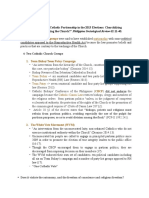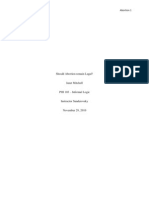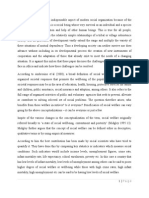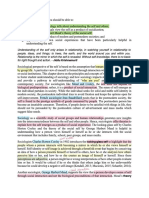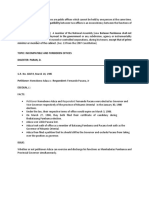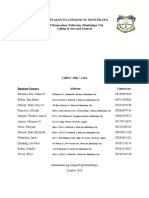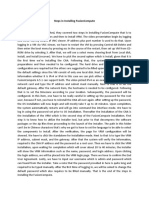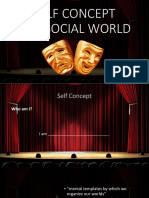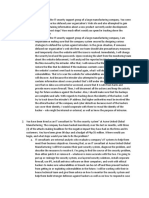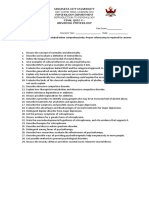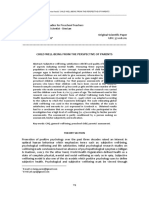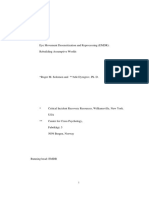Chapter 2
Chapter 2
Uploaded by
anniCopyright:
Available Formats
Chapter 2
Chapter 2
Uploaded by
anniOriginal Title
Copyright
Available Formats
Share this document
Did you find this document useful?
Is this content inappropriate?
Copyright:
Available Formats
Chapter 2
Chapter 2
Uploaded by
anniCopyright:
Available Formats
CHAPTER-II
CONCEPTUAL FRAMEWORK
Please purchase PDF Split-Merge on www.verypdf.com to remove this watermark.
43
Please purchase PDF Split-Merge on www.verypdf.com to remove this watermark.
CHAPTER II
CONCEPTUAL FRAMEWORK OF THE STUDY
Employees today are trying to balance their work and family life. Competing
demands which arise between work and personal roles often result in conflict among
employees. The last few decades have seen dramatic changes in the democratic
characteristics and lifestyle of the work force. The single most important change is the
increase of women into the work force especially that of married women with children
.With this change in many countries, dual earner families are becoming norm fast. When
one devotes extra time and energy in the work role, the family role is assumed to suffer
and vice-versa (Noor, 2003).Thus it leads to Role Conflict which affects the mental
health of women and leads to dissatisfaction of Life. Social support is believed to
alleviate the Role conflict in women and thus improving their mental health and
enhancing their life satisfaction. The conceptual frame work of the study variables are
derived from various theories which are discussed in detail in this chapter.
Many researchers have attempted to evolve theories that would well describe the
occurrence of the domains of work and family conflicts from their own perspectives.
In the literature, different theories have been used to characterize the relationship between
the work and family domains (Geurts & Demerouti, 2003; Rothbard & Dumas, 2006).
Some of the important theories are Segmentation Theory, The Compensation Theory,
Spillover Theory, Identity Theory, Conflict Theory and Role Theory.
Segmentation theory
The Segmentation Theory posited that the work and family domains are
inherently different and separate domains that do not influence each other in any way
(Dulin, 1956, Geurts & Demerouti, 2003; Rothbard & Dumas, 2006).
Compensation theory
Compensation theory hypothesized that people make an attempt to make up for
deprivations in one domain through greater involvement in the other. As such, it was thought
that the work domain could compensate for deprivations in the family domain and vice versa
(Geurts & Demerouti, 2003; Rothbard & Dumas, 2006; Wilkensy, 1960). Both theories have
received a little support in the empirical literature (Peeters & Heiligers, 2003).
44
Please purchase PDF Split-Merge on www.verypdf.com to remove this watermark.
Spillover theory
In contrast to these early theories, the dominant view in the current literature
which has received substantial empirical support is referred as to the ―Spillover theory‖.
Spillover theory, according to Fredriksen-Goldsen and Scharlach (2001), revolves around
the conceptualization that the work sphere can have a positive or negative impact on the
family sphere, meaning that attitudes and behaviors can create distress at home with family
members. This theory postulates that the work and family domain are interconnected because
people‘s attitudes, moods, values, habits and behavior can spill over from one domain to
the other, thus generating similarities between the two domains (Geurts & Demerouti, 2003:
Rothbard & Dumas, 2006).
Conflict theory
Conflict theory implies that there is an inevitable conflict between work and
family because both spheres are ―generally incompatible, given their differing demands,
responsibilities, expectations, and norms (Fredriksen-Goldsen & Scharlach, 2001). It is
assumed that anything at work will create some kind of conflict at home.
Identity theory
Identity theory is a micro sociological theory, which links self-attitudes, or
identities, to the role relationships and role-related behavior of individuals. Identity
theorists state that the self consists of a collection of identities, each of which is based on
occupying a particular role (Stryker & Burke, 2000).According to this theory, work is
seen as the salient role identity of men, and family as the salient role identity of women.
Identity theory states that stress and conflict between roles would arise when individuals
attempt to maintain a salient role identity in a situation that requires performance of
another identity and role. Therefore women who have a high investment in both work and
family would experience a great deal of work-family conflict (Stryker & Burke, 2000).
Role theory
Role is defined as expected behaviors come from some social status as the
separate spheres pattern; it sees family and work as a distinctive system that come from
sex role difference, domestic area for women and public area for men (Zedeck 1992).
45
Please purchase PDF Split-Merge on www.verypdf.com to remove this watermark.
Havighurst and Neugarten (1962) have defined role as a coherent pattern of behaviour
common to all persons who fill the same position or place in society and a pattern of
behaviour expected by other members of society. Role theory suggests that within social
settings, various social structures are formed (e.g., families, communities, work) that
require various roles that individuals fulfill (Parsons & Shils, 1951). With each social role,
there are certain duties, rights, norms, and behaviors expected. Involvement in multiple
roles (e.g., spouse, mother, father, manager, and worker) would lead to role conflict, role
strain (Barnett & Baruch, 1985; Kopelman, Greenhaus, Connolly, & Thomas, 1983), or
role overload (Baruch & Barnett, 1986). Role conflict occurs when a person is unable to
fulfill the responsibilities within each of their roles. This perceived ―conflict‖ can be a
result of external constraints prohibiting an individual from fulfilling their multiple role
responsibilities (Barnett & Baruch, 1985; Coverman, 1989; Kopelman et al., 1983).
Role strain has been defined by Goode (1960) as ―felt difficulty in performing
role obligations‖. Role overload is often experienced as a result of having too little time
to fulfill various role demands (Barnett & Baruch, 1985). Some researchers posit that
engaging in multiple roles may leave insufficient time to fulfill the various demands and
responsibilities inherent to an individual‘s roles, resulting in depletion of time and energy
(Coverman, 1989). Role conflict and role overload have been shown to have negative
effects on psychological well-being, job satisfaction, and marital satisfaction (Coverman,
1989). Competing demands may require additional time, energy, and resources, and thus
can result in the experiences of strain and conflict (Goode, 1960) if the individual does
not have enough resources to meet multiple demands.
Summarization of Theories
While summarizing all the theories, Segmentation theory is based on the assumption
that since energy and time are limited, resources taken up in one role mean that the other
role is neglected. The compensation theory states that if individuals are not satisfied in
one role they will seek satisfaction in the other role. Spillover theory is based on the
carryover of attitudes from one role to another. Conflict theory implies that that work
demands will conflict with home. Identity theory states that individuals have various
roles which they are expected to fulfill due to their gender or status in society. These
46
Please purchase PDF Split-Merge on www.verypdf.com to remove this watermark.
individuals have other roles as well it may conflict with their primary role. The role
theory states that conflict occurs when individuals are engaged in multiple roles that are
incompatible (Katz & Kahn, 1978).
In the present study, the researcher intended to study the Role Conflict of the
married women teachers who play the multiple roles such as wife, mother, daughter in
law, sister in law, teacher, employer etc; Though all these theories explain the domains of
work and family conflicts, Role theory explains about the multiple roles played by an
individual in the society which is the foundation of work family research. Role theory
states that fulfilling multiple roles will inevitably lead to experiencing role conflict which
relates to higher levels of stress and decreased satisfaction and motivation at work and
life .Hence Role Theory lays the foundation of the conceptual framework for one of the
current study variable Role Conflict.
Social Support
The positive role of social support on work-family conflict contributes to how the
employee copes with stress and may improve work family relationships. Social support is
believed to have a positive impact on the working roles performed by women at work
places by enhancing job satisfaction and creating balance, thereby eliminating work-
family conflicts (Carlson and Perrewe, 1999). It is one of the important resources for
working women to manage their work and family domains. Amatea and Fong (1991)
found that professional women who experienced higher levels of social support as well as
a greater number of roles occupied, reported lower levels of strain symptoms as
compared to those who experienced lower levels of social support.
Social support is defined as the "existence or availability of people on whom we
can rely, people who let us know that they care about, value, and love us" (Sarason,
Levine, Basham, & Sarason, 1983).Multidimensionality of social support has been
widely acknowledged. In a detailed literature review by Weaver (2000), social support is
described in terms of its type, function, and source. House (1981) identified four types of
social support; emotional, appraisal, informational, and instrumental. On the other hand,
Ben-David and Leichtentritt (1999) described social support in terms of its function as
the level of meeting one's needs by interaction with others. Caplan (1974) described
47
Please purchase PDF Split-Merge on www.verypdf.com to remove this watermark.
social support as a functional and informative counseling service; Cobb (1976) described
it as knowledge. Of all these, the most preferred definition of social support is the one
based on the sources of that support. According to Zimet, Dahlem, Zimet, and Farley
(1988) these sources are family, friends, and significant other.
Models of Social Support
There are two main models of social support such as buffering model and the
direct effects model addressing the link between social support and health. The main
difference between these two models is that the direct effects model predicts that social
support is beneficial all the time, while the buffering model predicts that social support is
mostly beneficial during stressful times
In the buffering model, social support protects (or "buffers") people from the bad
effects of stressful life events (e.g., death of a spouse, job loss etc). Evidence for stress
buffering is found when the correlation between stressful events and poor health is weaker
for people with high social support than for people with low social support. The weak
correlation between stress and health for people with high social support is often interpreted
to mean that social support has protected people from stress. Stress buffering is more
likely to be observed for received support than for social integration or perceived support.
In the direct effects (also called main effects) model, people with high social support
are in better health than people with low social support, regardless of stress. In addition to
showing buffering effects, perceived support also shows consistent direct effects for
mental health outcomes. Both perceived support and social integration show main effects
for physical health outcomes. Received (enacted) support rarely shows main effects.
Theories of Social Support
The theoretical perspective on social support research indicates that the
availability of social support contributes to overall wellbeing (Lakey & Cohen, 2000).
Several theories such as Stress and coping social support theory, Relational regulation
theory (RRT) and Life-span theory have been proposed to explain social support‘s link to
health .These theories are explained below.
48
Please purchase PDF Split-Merge on www.verypdf.com to remove this watermark.
Stress and coping social support theory
This theory dominates social support research and explains the buffering model.
According to this theory, social support protects people from the bad health effects of
stressful events (i.e., stress buffering) by influencing how people think about and cope
with the events. According to stress and coping theory, events are stressful insofar as
people have negative thoughts about the event (appraisal) and cope ineffectively. Coping
consists of deliberate, conscious actions such as problem solving or relaxation. As applied to
social support, stress and coping theory suggests that social support promotes adaptive
appraisal and coping. Evidence for stress and coping social support theory is found in
studies that observe stress buffering effects for perceived social support. One problem
with this theory is that, as described previously, stress buffering is not seen for social
integration, and that received support is typically not linked to better health outcomes.
Relational regulation theory (RRT)
Relational regulation theory (RRT) is another theory, which is designed to explain
main effects (the direct effects hypothesis) between perceived support and mental health.
As mentioned previously, perceived support has been found to have both buffering and
direct effects on mental health. RRT was proposed in order to explain perceived support‘s
main effects on mental health which cannot be explained by the stress and coping theory.
RRT hypothesizes that the link between perceived support and mental health comes from
people regulating their emotions through ordinary conversations and shared activities
rather than through conversations on how to cope with stress. This regulation is relational
in that the support providers, conversation topics and activities that help regulate emotion
are primarily a matter of personal taste. This is supported by previous work showing that
the largest part of perceived support is relational in nature.
Life-span theory
Life-span theory is another theory to explain the links of social support and
health, which emphasizes the differences between perceived and received support.
According to this theory, social support develops throughout the life span, but especially
in childhood attachments with parents. Social support develops along with adaptive
personality traits such as low hostility, low neuroticism, high optimism, as well as social
49
Please purchase PDF Split-Merge on www.verypdf.com to remove this watermark.
and coping skills. Together, support and other aspects of personality influence health
largely by promoting health practices (e.g., exercise and weight management) and by
preventing health-related stressors (e.g., job loss, divorce). Evidence for life-span theory
includes that a portion of perceived support is trait-like and that perceived support is
linked to adaptive personality characteristics and attachment experiences.
The above theories show the link of social support and health outcomes.
Relational regulation theory (RRT) in particular explains that perceived support has been
found to have both buffering and direct effects on mental health. Perceived social support
refers to a person's perception of readily available support from friends, family, and
others. It also shows the complex nature of social support including both the history of
the relationship with the individual who provides the supportive behavior and the
environmental context (Hobfoll & Vaux, 1993). Hence the researcher adopted the
Relational regulation theory (RRT) which is one of the Social support theories for the
study since the perceived social support show direct effect on mental health.
Mental health
There have been many attempts to describe mental health in ideal terms which
have generally led to list of qualities which characterize the mature, healthy, fully
functioning, self actualization. The study of the characteristics that make up mental health
has been called positive psychology. Positive psychology is primarily concerned with the
scientific study of human strengths and happiness (Carr, 2004). One of the distinguishing
features of positive psychology is a focus on what constitutes the type of life that leads to
the greatest sense of well-being, satisfaction or contentment and the good life for a
human being. The good life refers to the factors that contribute most to a well lived and
fulfilling life (Compton, 2005). The World Health organization defines mental health as
"a state of wellbeing in which the individual realizes his or her own abilities, can cope
with the normal stresses of life, can work productively and fruitfully, and is able to make
a contribution to his or her community". The definition clearly shows that mental health
is a state of wellbeing which is a multi-dimensional construct in which human beings are
active in the process of living their lives to the fullest.
50
Please purchase PDF Split-Merge on www.verypdf.com to remove this watermark.
Different theoretical models of well-being currently exist and each model
discusses different dimensions of well-being. Some of the theoretical models are the
wheel of wellness model, Perception of wellness model, Lightsey‘s process of well-being
and Ryff‘s multi-dimensional model of well-being.
Wheel of wellness model
Myers, Sweeney and Witmer (2000) proposed a wheel of wellness to accommodate
the developmental dimension in a wellness model. The model proposed five life tasks,
depicted in a wheel, which are interrelated and interconnected. Those five tasks were
essence or spirituality, work and leisure, friendship, love, and self direction. The life task
of self direction were further subdivided into the 12 tasks of (a) sense of worth, (b) sense
of control, (c) realistic beliefs, (d) emotional awareness and coping, (e) problem solving
and creativity, (f) sense of humor, (g) nutrition, (h) exercise, (i) self care, (j) stress management,
(k) gender identity, and (l) cultural identity. These life tasks interact dynamically with a
variety of life forces, including but not limited to one‘s family, community, religion,
education, government, media, and business/industry. Els and De la Rey (2006) built on
Myers, Sweeny and Witmer‘s wheel of wellness to include additional dimensions. They
view wellness as a 19- dimensional construct. Consisting of self-worth, institutional
concern, personal attributes, local safety, social identity, work, self-care, friendship,
emotion, stress management, realistic beliefs, nutrition, intelligence, humor, leisure,
gender identity, love, spirituality and exercise. These 19 dimensions are quite complex in
their aim to be holistic and probably could be grouped under the main dimensions as
proposed by Myers, Luecht and Sweeney (2004).
Myers, Luecht and Sweeney (2004) built on their initial conceptualization of the
wellness wheel and its complimentary Wellness Evaluation of Lifestyle (WEL) which
consisted of five factors. This higher order dimensionality of wellness is similar to that
found by Ryff and Keyes (1995), who found a single higher order factor underlying their
six scales of self-acceptance, positive relations with others, autonomy, environmental
mastery, purpose in life, and personal growth. This re-examination led to the development of
the Indivisible Self Wellness model (Sweeney & Myers, 2005). Similar to the original
Wheel model, the IS-Wel is contextual. The contexts are more clearly defined and
51
Please purchase PDF Split-Merge on www.verypdf.com to remove this watermark.
described in terms of local, institutional, global and chronometrical components through
which the individual affects and is affected by his or her environment. Changes through time
are included in the newer model, because wellness involves the acute and chronic effects of
lifestyle behaviors and choices throughout an individual‘s life span (Myers et al., 2000).
Perception of wellness Model
Adams, Bezner and Steinhardt (1997) strongly worked on with the perception of
wellness. According to them, perceived wellness is a multi-dimensional, salutogenic
construct, which should be conceptualized, measured, and interpreted consistent with an
integrated systems view. They chose six dimensions for their wellness model, based on
the strength of theoretical support and the quality of empirical evidence supporting each.
The six dimensions were Physical Wellness, Spiritual Wellness, Psychological Wellness,
Emotional Wellness and Intellectual Wellness. A major advantage of Adams et al. (1997)
perceived wellness theory is that it takes a salutogenic and systems approach. This
implies that each part of the system is both an essential sub element of a larger system
and an independent system with its own sub elements.
Lightsey‟s process of well-being
Lightsey (1996) developed his model of well-being based on empirical research
done on the effect of psychological resources, such as optimism, self-efficacy and positive
thoughts. He suggested a process theory of psychological resources and adaptation.
The term process is used to convey the sense of a person as a dynamic system that exists
only in relationship to environment. His model starts with the natural tendency of all
people to appraise the environment and themselves. Appraise constitutes an active
construction of reality and entails the use of a) the rational processing system and b) the
experiential processing system. The rational system is analytic, logic, relatively slow,
relatively easy to change and conscious. Within this system, thoughts and beliefs pertain
either to self or to outcomes and may be either positive or negative and adaptive or non
adaptive. The balance between negative thoughts and positive thoughts and between
negative beliefs and positive beliefs is more important than the absolute number of
negative thoughts in most circumstances. This balance is important primarily insofar as it
52
Please purchase PDF Split-Merge on www.verypdf.com to remove this watermark.
reflects the balance in activation of positive emotion and negative emotion. The experiential
system consists of schemas. Beliefs gradually form and shape schemas (implicit theories
of the world).
Schemas are very difficult to change, very general, rapid, relatively undifferentiated
and powerfully linked to positive and negative emotions. Because of its efficiency, its
unconscious nature and its intimate connections to feelings, the experiential system
effects human behavior far more than the cognitive systems. Negative schemas are
central to immediate, preconscious ―fight or flight‖ processing that evolved as a means of
surviving physical danger. When activated, negative schemas typically account for more
variance in behavior than even activated positive schemas. Positive schemas about others
lead to approach behaviors that typically beget rewarding social relationships which, in
turn, lead to further development and more frequent activation of positive schemas.
The major contribution Lightsey (1996) makes is the balance his model brings between
personality and environment. This contributes greatly to the understanding of well-being,
but his is a complex model that asks attention for a lot of interrelated concepts.
Ryff‟s multi-dimensional model of well-being
According to Ryff (1989) there has been particular neglect at the most fundamental
realm of defining well-being, namely the task of defining the essential features of
psychological well-being. She argued that much of the prior literature is founded on
conceptions of well-being that have little theoretical rationale and, as a consequence,
neglect important aspects of positive functioning. The absence of theory-based formulations
of well-being is puzzling given abundant accounts of positive functioning on subfields of
psychology. From developmental psychology, Erikson‘s (1959) psychosocial stages,
Buhler‘s (1935) basic life tendencies, and Neugarten‘s (1973) personality changes
articulate wellness as trajectories of continued growth across the life cycle. Clinical
psychologists offer further descriptions of well-being through Maslow‘s (1968) conception
of self-actualization, Allport‘s (1961) formulation of maturity, Rogers‘ (1961) depiction
of the fully functioning person and Jung‘s (1933) account of individuation.
The mental health literature, which typically elaborates the negative end of
psychological functioning, nonetheless includes some exposition of positive health
(Birren & Renner, 1980; Jahoda, 1958). The convergence of these multiple frameworks
53
Please purchase PDF Split-Merge on www.verypdf.com to remove this watermark.
of positive functioning served as the theoretical foundation to generate a multi-
dimensional model of well-being. Included are six distinct components of positive
psychological functioning. In combination, these dimensions encompass a breath of wellness
that includes positive evaluation of oneself and one‘s past life (Self-Acceptance), a sense of
continued growth and development as a person (Personal Growth), the belief that one‘s
life is purposeful and meaningful (Purpose in Life), the possession of quality relationships
with others (Positive Relations with Others), the capacity to manage effectively one‘s life
and surrounding world (Environmental Mastery), and a sense of self-determination
(Autonomy) (Ryff & Keyes,1995). In this model Ryff manages to acknowledge the
multi-dimensional aspect of wellbeing, implying that well-being is a well functioning
system interacting with its environment. She also manages to keep the whole system
manageable.
Of these models, those of Ryff and Keyes, Sweeny and Witmer and Myers, were
referred to the most in the review of the literature (Dolan, Peasgood & White, 2006;
Hattie, Myers, Sweeney, 2004; Myers, Savolaine & Granello, 2002; Myers, Sweeney and
Witmer, 2000; Sheldon & Lyubomirsky, 2006). Thus the researcher made use of the Ryff
and Keyes‘ model which has a thorough theoretical basis as well as empirical evidence
with multifaceted domain encompassing of positive self regard (Positive self evaluation),
mastery of the surrounding environment (environmental mastery), quality relationships with
others (group attitudes), continued growth and development (Integration of personality),
purposeful living (realistic perception) and the capacity for self-determination (Autonomy).
A good mental health indicates a satisfied life. Studies show that working women
report higher levels of depression, anxiety and suffer from other psychological problems
which lead to low levels of life satisfaction.
Life Satisfaction
Satisfaction with life is one of the fundamental goals people try to achieve.
In general, the word satisfaction means appreciation of life, subjective evaluation
standard of various phenomena, states, activities and objects, including one‘s self,
experienced as a pleasant feeling of joy, success or satisfaction with previous work or
activity (Strmen, Raiskup, 1998). J. Fahrenberg et al. (2000) describes as individual
54
Please purchase PDF Split-Merge on www.verypdf.com to remove this watermark.
evaluation of past and current life conditions and life expectations. D.C. Shin and
D.M. Johnson (1978) defines life satisfaction as global evaluation of one‘s quality of life
according to criteria chosen by oneself. The global character of life satisfaction is
accented also by D. M. Haybron (2001), who thinks the overall positive attitude towards
life to be essential and impossible to be reduced to a mere summary of separate experiences
of contentedness and discontentedness. According to various authors, life satisfaction
together with affective elements creates a relatively complete picture of subjective well
being (Andrews, Whitney 1976, Herzog, Rodgers, Woodworth, 1982).
Several theories have contributed to conceptualize Life Satisfaction in which the
two main theories are Bottom up Theory and Social Judgment Theory.
Bottom-up theory
Bottom-up theory underscores the notion that overall global evaluations of life
satisfaction are a function of evaluations made in various life domains such as family life,
social life, leisure life, financial life, community life, spiritual life, and so on. In other
words, evaluations of life domains influence the evaluation of life overall, especially
important life domains. Many indicator projects and Quality of Life measures use
bottom-up theory implicitly or explicitly. Frisch (2006) developed his Quality of Life
Inventory to rate the satisfaction of life domains such as health, self-esteem, goals and
values, money, work, pay, learning, helping, love, friends, children, relatives, home,
neighborhood, and community. Another widely used QOL measure based on bottom-up
theory is the Personal Well-Being Index or PWBI (Cummins et al., 2003). Robert
Cummins and his wide network of colleagues worldwide have a program of research
related to the PWBI, which proposes that satisfaction with life is directly influenced by
satisfaction in seven different life domains. Many large-scale indicator projects have
developed their own version of QOL indices based on bottom-up theory.
Social Judgment Theory
Social judgment theory posits that people do make judgments about their life
overall or certain aspects of their lives (e.g., community well-being) using some reference
(or standard of comparison). The Eaterlin Paradox is essentially based on social judgment
theory (Easterlin 1974). The argument is that the impact of income on subjective
55
Please purchase PDF Split-Merge on www.verypdf.com to remove this watermark.
wellbeing depends on standards of comparisons that people use in making evaluations
about their standard of living. These standards of comparison change over time according
to the individual‘s expectations and social comparisons.
Another social judgment theory in QOL research is Alex Michalos‘ multiple
discrepancies theory (Michalos 1985; Lance et al., 1995). According to this theory,
satisfaction is determined by one‘s perceptions of ―how things are‖ vs. ―how they should
be.‖ Comparisons between how things are and what one wants, what one had, what one
expected, what others have, and what one feels one deserves combine to determine life
satisfaction. Michalos‘ theory helps us understand how people make global evaluations
about their life using standards such as the ideal life, the deserved life, past life, current
life, future life, etc. (cf. Meadow et al., 1992; Sirgy et al., 1995).
Other mini-theories subsumed under social judgment theory include social
comparison theory (Diener and Fujita 1997), goals and aspirations (e.g., Emmons 1992;
Carver et al. 1996; Kasser and Ryan 1996), adaptation and coping (e.g., Brickman et al.,
1978; Mehnert et al., 1990), among others. QOL researchers developed many QOL
measures based on social judgment theory such as Satisfaction with Life Scale (Pavot and
Diener 1993; Pavot et al. 1991), the Congruity Life Satisfaction measure (Meadow et al.,
1992; Sirgy et al., 1995), the Delighted-Terrible Scale (Andrew and Withey 1976), the
Cantril Ladder (Cantril 1965), the Happiness Scale (Veenhoven 1996), and the like.
The vast majority of these operationalizations of subjective well-being can be explained
using social judgment theory of well-being.
In the current study, the life satisfaction is conceptualized based on the Social
Judgment theory in which the married women teachers assess their Life Satisfaction
based on judgments about the overall life both positively and negatively.
56
Please purchase PDF Split-Merge on www.verypdf.com to remove this watermark.
You might also like
- Weeks 2-4: Cases and Stages - ARGDocument4 pagesWeeks 2-4: Cases and Stages - ARGanni100% (3)
- Ucsp Conformity and DevianceDocument49 pagesUcsp Conformity and Devianceadelainne.mtNo ratings yet
- Annotated BibliographyDocument5 pagesAnnotated Bibliographyapi-220235297No ratings yet
- PSY 202 Essay On Self-Determination TheoryDocument2 pagesPSY 202 Essay On Self-Determination TheorySlimNo ratings yet
- Edsa 2Document2 pagesEdsa 2Dahlia Claudine May PerralNo ratings yet
- Catholic Church GroupsDocument3 pagesCatholic Church GroupscazzmereNo ratings yet
- Reflection On My Personal Dilemma in The Past YearDocument1 pageReflection On My Personal Dilemma in The Past YearanniNo ratings yet
- Activity 4 Cavite MutinyDocument2 pagesActivity 4 Cavite Mutinyanni100% (2)
- Cognitive Behavioral TherapyDocument1 pageCognitive Behavioral TherapyzulkaberNo ratings yet
- CounsellingDocument44 pagesCounsellingNaresh Kumar Reddy75% (4)
- Abnormal Psychology Study GuideDocument243 pagesAbnormal Psychology Study GuideAllissa Michelle Kimker83% (23)
- 082-Cognitive Behavior Therapy, Second Edition - Basics and Beyond-Judith S. Beck PHD Aaron T. BeDocument17 pages082-Cognitive Behavior Therapy, Second Edition - Basics and Beyond-Judith S. Beck PHD Aaron T. BeMarta ParaschivNo ratings yet
- Harry SullivanDocument24 pagesHarry SullivanJasmin JaoNo ratings yet
- Article III, Section 4Document2 pagesArticle III, Section 4x483xDNo ratings yet
- Research2ndsem1 2 3 1Document22 pagesResearch2ndsem1 2 3 1Airess SuelloNo ratings yet
- Stages of Moral DevelopmentDocument3 pagesStages of Moral DevelopmentAudrey Natanauan100% (1)
- Community OrganizingDocument39 pagesCommunity OrganizingEloisa Joy MoredoNo ratings yet
- Journal ArticleDocument7 pagesJournal ArticleImmaculately Pretty0% (1)
- Review of Related Literature and Studies Related LiteratureDocument6 pagesReview of Related Literature and Studies Related LiteratureLeonard MedinaNo ratings yet
- Workplace BullyingDocument4 pagesWorkplace BullyingSadia SiddiqNo ratings yet
- DISS Module Week 5-7Document9 pagesDISS Module Week 5-7Airene NopalNo ratings yet
- AntiTerrorism Act of 2020Document2 pagesAntiTerrorism Act of 2020Jeric LargoNo ratings yet
- AbortionDocument10 pagesAbortionJanet Mitchell BoehmNo ratings yet
- Theories of SocietyDocument3 pagesTheories of Societymarc louie tiraoNo ratings yet
- Module 2.1 Globalization Thru MEDIADocument11 pagesModule 2.1 Globalization Thru MEDIAAilene Nace GapoyNo ratings yet
- Feist8e SG CH07Document21 pagesFeist8e SG CH07Daniel Culla0% (1)
- Bangsamoro Organic LawDocument6 pagesBangsamoro Organic LawNikkaDoriaNo ratings yet
- Assessing The Compliance of Balanced Housing Policy in The Philippines: The Case of Davao CityDocument8 pagesAssessing The Compliance of Balanced Housing Policy in The Philippines: The Case of Davao CityLiz ZieNo ratings yet
- Domains of DevelopmentDocument2 pagesDomains of Developmentjohn johnNo ratings yet
- Chapter Title Theoretical Perspectives On Sex and Gender 2. Intended Learning OutcomesDocument9 pagesChapter Title Theoretical Perspectives On Sex and Gender 2. Intended Learning OutcomesAPPLE MAE JimenoNo ratings yet
- Social Interactionist TheoryDocument5 pagesSocial Interactionist TheoryLeandro LahindoNo ratings yet
- Ucsp Week 8Document4 pagesUcsp Week 8Cathlyn AlvarezNo ratings yet
- Interpersonal Theory of Harry Stack Sullivan 2Document26 pagesInterpersonal Theory of Harry Stack Sullivan 2Georgianne MarforiNo ratings yet
- Philoo 4 EDITDocument2 pagesPhiloo 4 EDITmkay cabahugNo ratings yet
- Argumentative Essay Final DraftDocument7 pagesArgumentative Essay Final Draftapi-430938531No ratings yet
- Overview of The Three Branches of The Philippine GovernmentDocument9 pagesOverview of The Three Branches of The Philippine GovernmentFliss YvuseinNo ratings yet
- 1 Introduction To Law and Society and Reasons For LawsDocument19 pages1 Introduction To Law and Society and Reasons For Lawsapi-88846630100% (2)
- Speech PovertyDocument3 pagesSpeech PovertyKnishca IezaNo ratings yet
- CyberbullyingDocument3 pagesCyberbullyingkwai pengNo ratings yet
- What Is LawDocument13 pagesWhat Is LawAayush SinhaNo ratings yet
- BSW 111 - Introducion To Social Welfare Ass 1Document7 pagesBSW 111 - Introducion To Social Welfare Ass 1Evangelist Kabaso Sydney100% (2)
- Social Conflict TheoryDocument1 pageSocial Conflict TheoryDela paz Mark GilNo ratings yet
- Thesis Abstract (Ateneo de Davao University Undergraduate Thesis)Document3 pagesThesis Abstract (Ateneo de Davao University Undergraduate Thesis)Shevy Sarigumba (blue butterfly)No ratings yet
- Political BehaviorDocument50 pagesPolitical BehaviornikkivNo ratings yet
- RRLDocument7 pagesRRLCarla Mae NolascoNo ratings yet
- Chapter 2 Sociological Perspective The Self As A Product of SocietyDocument3 pagesChapter 2 Sociological Perspective The Self As A Product of SocietyPearl NecoleNo ratings yet
- Modern Philosophy EssayDocument4 pagesModern Philosophy EssayАнна ЛащукNo ratings yet
- John LockeDocument2 pagesJohn LockeeeshkafrostedamberNo ratings yet
- Coping Mechanism of A Person With Disability Suffering Stage FrightDocument37 pagesCoping Mechanism of A Person With Disability Suffering Stage FrightGherbe CastañaresNo ratings yet
- Premature EvaluationDocument1 pagePremature EvaluationShivam TiwariNo ratings yet
- A Position Paper in Favor of DivorceDocument2 pagesA Position Paper in Favor of DivorceReign MoranNo ratings yet
- Philipphine Politics and GovernanceDocument57 pagesPhilipphine Politics and GovernanceBernadette ReyesNo ratings yet
- Petitioner Homobono Adaza and Respondent Fernando Pacana Were Elected As Governor andDocument5 pagesPetitioner Homobono Adaza and Respondent Fernando Pacana Were Elected As Governor andzeynNo ratings yet
- Louis Gottschalk History and Historical SourcesDocument7 pagesLouis Gottschalk History and Historical SourcesRazel Bayangos SevillenoNo ratings yet
- CWTS Reviewer 1Document6 pagesCWTS Reviewer 1DonnaFaithCaluraNo ratings yet
- Social Media Has Drastically Changed How We CommunicateDocument7 pagesSocial Media Has Drastically Changed How We CommunicateUnokhogie EmmanuelNo ratings yet
- Theories of Personality 8 (Harry Stack Sullivan)Document45 pagesTheories of Personality 8 (Harry Stack Sullivan)Anne Jeanneth DiazNo ratings yet
- History and Forerunners in SociologyDocument2 pagesHistory and Forerunners in SociologyCristina Bermudez Alas-as100% (3)
- "I Journey With The Dream" - Life of SJBDLSDocument4 pages"I Journey With The Dream" - Life of SJBDLSRita Angela DeLeonNo ratings yet
- The Oral Stage (: Psychosexual TheoryDocument3 pagesThe Oral Stage (: Psychosexual Theoryjustine jeraoNo ratings yet
- Phil Pol 3 (The Concept of Power) Students'Document2 pagesPhil Pol 3 (The Concept of Power) Students'AndreiNo ratings yet
- Primary GroupsDocument57 pagesPrimary GroupsRonald GuevarraNo ratings yet
- Trends, Networks, and Critical Thinking in The 21 CenturyDocument34 pagesTrends, Networks, and Critical Thinking in The 21 CenturyFritzie SajulNo ratings yet
- Chapter3 Magstadt Simple BackgroundDocument11 pagesChapter3 Magstadt Simple BackgroundPam BamaNo ratings yet
- C123 - 12 Humss eDocument29 pagesC123 - 12 Humss eShalyn IbnosaliNo ratings yet
- The Real DebateDocument6 pagesThe Real DebatePatria PrastikaNo ratings yet
- 8 Aminah Ahmad1 PDFDocument9 pages8 Aminah Ahmad1 PDFMas Roy TambbachEleggNo ratings yet
- Pamantasan NG Lungsod NG Muntinlupa NBP Reservation, Poblacion, Muntinlupa City College of Arts and SciencesDocument10 pagesPamantasan NG Lungsod NG Muntinlupa NBP Reservation, Poblacion, Muntinlupa City College of Arts and Sciencesanni100% (1)
- Pamantasan NG Lungsod NG Muntinlupa Department of PsychologyDocument57 pagesPamantasan NG Lungsod NG Muntinlupa Department of Psychologyanni100% (1)
- CasesDocument2 pagesCasesanniNo ratings yet
- OXO or Tic-Tac-Toe in 1952 For Doctoral Dissertation at University of Cambride, Followed by ADocument2 pagesOXO or Tic-Tac-Toe in 1952 For Doctoral Dissertation at University of Cambride, Followed by AanniNo ratings yet
- Title of The Reading: Hard To Imagine 1. SummaryDocument2 pagesTitle of The Reading: Hard To Imagine 1. Summaryanni0% (1)
- 01 Worksheet 1ADocument2 pages01 Worksheet 1AanniNo ratings yet
- 07 Tactical Information SystemsDocument1 page07 Tactical Information SystemsanniNo ratings yet
- Data PrivacyDocument5 pagesData PrivacyanniNo ratings yet
- NIH Public Access: The Relationship Between Social Support and Subjective Well-Being Across AgeDocument20 pagesNIH Public Access: The Relationship Between Social Support and Subjective Well-Being Across AgeanniNo ratings yet
- Rizzi - Ethics 2Document1 pageRizzi - Ethics 2anniNo ratings yet
- Examination of The Relationship Between Life Satisfaction and Perceived Social SupportDocument8 pagesExamination of The Relationship Between Life Satisfaction and Perceived Social SupportanniNo ratings yet
- Steps in Installing FusionComputeDocument1 pageSteps in Installing FusionComputeanniNo ratings yet
- Self ConceptDocument32 pagesSelf ConceptanniNo ratings yet
- The Retraction Controversy of Dr. Jose Rizal: Submitted byDocument9 pagesThe Retraction Controversy of Dr. Jose Rizal: Submitted byanni100% (1)
- Current Issue All Over Your FaceDocument7 pagesCurrent Issue All Over Your FaceanniNo ratings yet
- IAS HomeworkDocument5 pagesIAS HomeworkanniNo ratings yet
- Prof IssuesDocument2 pagesProf IssuesanniNo ratings yet
- Midterm The Site of The First MassDocument5 pagesMidterm The Site of The First MassanniNo ratings yet
- Document Analysis: I. Functional RequirementsDocument1 pageDocument Analysis: I. Functional RequirementsanniNo ratings yet
- Janet Sayers' Freud's Art - Book ReviewDocument4 pagesJanet Sayers' Freud's Art - Book ReviewNeha ChoksiNo ratings yet
- Self Help Course 1Document10 pagesSelf Help Course 1shaheemk13No ratings yet
- Syllabus: Internships in Clinical Psychology Jan. - Jun. / Jul. - DecDocument5 pagesSyllabus: Internships in Clinical Psychology Jan. - Jun. / Jul. - DecVani JainNo ratings yet
- The Dynamics of Flourishing Indonesian Muslim FamiliesDocument18 pagesThe Dynamics of Flourishing Indonesian Muslim FamiliesAlvi YanvaNo ratings yet
- Urdaneta City University Psychology Department Final Quiz 4 - Abnormal PsychologyDocument1 pageUrdaneta City University Psychology Department Final Quiz 4 - Abnormal PsychologyMaestro OdamitsalNo ratings yet
- Hare Psychopathy Checklist ReviewedDocument7 pagesHare Psychopathy Checklist Reviewedraluca_ghigaNo ratings yet
- Schizo PhreniaDocument9 pagesSchizo PhreniaCharles IppolitoNo ratings yet
- Comprehensive Psychiatric EvaluationDocument5 pagesComprehensive Psychiatric EvaluationfrankieNo ratings yet
- Depression: Juan David Caldon Rojas Oral Communication Libert Alonso Vergara National UniversityDocument11 pagesDepression: Juan David Caldon Rojas Oral Communication Libert Alonso Vergara National UniversityJuan David Caldon RojasNo ratings yet
- ToP - Chapter 9 Maslow & Holistic-Dynamic TheoryDocument9 pagesToP - Chapter 9 Maslow & Holistic-Dynamic TheoryVivianna GarciaNo ratings yet
- Abuse, Trauma, and Torture - Their Consequences and EffectsDocument247 pagesAbuse, Trauma, and Torture - Their Consequences and EffectsSam Vaknin93% (15)
- Tanja Panić: Child Well-Being From The Perspective of ParentsDocument9 pagesTanja Panić: Child Well-Being From The Perspective of ParentsMagdalena BozinoskaNo ratings yet
- Eye Movement Desensitization and Reprocessing (EMDR)Document23 pagesEye Movement Desensitization and Reprocessing (EMDR)Monica Istrate100% (1)
- Chapter 1 Power Point Counseling TechniquesDocument23 pagesChapter 1 Power Point Counseling TechniquesHammad TauqeerNo ratings yet
- Psy460 Ch07 HandoutDocument6 pagesPsy460 Ch07 HandoutDev PrashadNo ratings yet
- Jurnal Fobia Sosial IDocument9 pagesJurnal Fobia Sosial IYurnisa FauziahNo ratings yet
- Ocd (Quick) PDFDocument18 pagesOcd (Quick) PDFAla AbushehabNo ratings yet
- Homosexuality Anxiety: A Misunderstood Form of OCD: Monnica WilliamsDocument11 pagesHomosexuality Anxiety: A Misunderstood Form of OCD: Monnica WilliamsMaria Nicole VaneeteeNo ratings yet
- SRS-WPS OfficeDocument3 pagesSRS-WPS OfficeDwi KrisdiyantoNo ratings yet
- Subjective Well - BeingDocument18 pagesSubjective Well - Beingfalguni100% (2)
- A Sobering Fact ADHD Leads To Substance AbuseDocument3 pagesA Sobering Fact ADHD Leads To Substance Abuseammarashor78No ratings yet
- English Presentation NotesDocument3 pagesEnglish Presentation Notesdswhitham8365No ratings yet
- Play TherapyDocument6 pagesPlay Therapy妙慈No ratings yet
- I. Demographic ProfileDocument3 pagesI. Demographic Profilejay ar baybayNo ratings yet
- A Description of Karen Horney's Neo-Freudian Theory of PersonalityDocument3 pagesA Description of Karen Horney's Neo-Freudian Theory of PersonalityTamizharasi UdhayasuriyanNo ratings yet
- Ocd SlideshowDocument9 pagesOcd Slideshowapi-388770598No ratings yet





